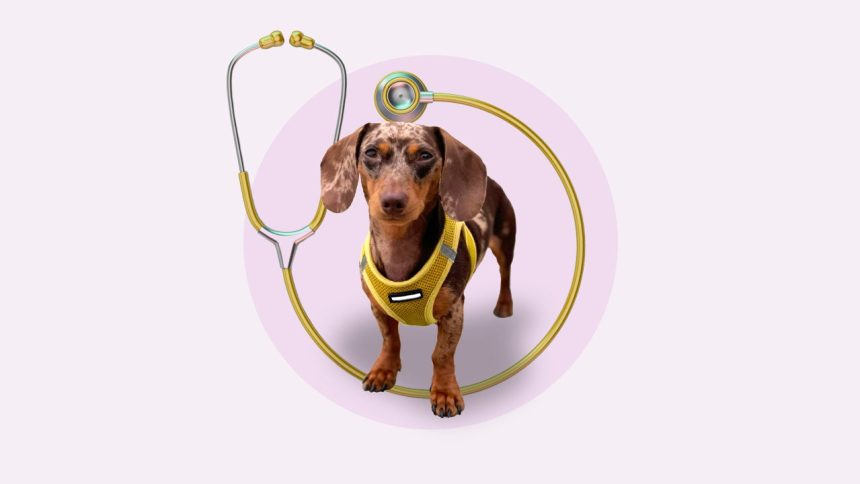Routine vet care is essential to keeping your pet healthy, but it can also be a significant financial commitment. As a pet owner, you might wonder how much routine vet care costs and if it’s worth getting pet insurance to help pay for it.
The answer to how much to expect vet care to be is complicated. Costs are influenced by many factors, including your pet’s age, breed and location. It also depends on if you have a pet insurance plan that covers that condition.
Typical routine pet health care
Routine pet health care is crucial for ensuring long-term pet well-being. This care typically includes regular veterinary check-ups, vaccinations, parasite prevention, dental care and grooming.
Regular vet visits are vital for monitoring a pet’s overall health, allowing for early detection of potential issues such as dental disease, obesity or signs of chronic conditions. Vaccinations protect pets from serious and sometimes fatal diseases. At the same time, parasite prevention shields them from fleas, ticks and internal parasites like worms.
Dental care plays a significant role in a pet’s overall health, as untreated dental issues can lead to pain, infections and even heart problems. Grooming is not just about maintaining appearance. It also helps prevent skin issues, keeps the coat healthy and allows for the early detection of lumps, bumps or other skin abnormalities.
Routine care establishes a baseline of good health, making it easier to notice when something is amiss. This is key to early intervention and treatment. Routine care can help pet owners prevent many health problems, improve their pet’s quality of life and potentially extend their pet’slifespan.
Routine pet health care costs breakdown
The costs of these routine care services can add up over time, depending on the specific needs of your pet and the frequency of care required.
Veterinary exam fees
Veterinary exam fees can vary based on location, the type of veterinary practice and the specific services included in the exam. Looking at the average cost of fees in your state may help you get an idea of what to expect.
Vaccination fees
Vaccinations are a vital part of your pet’s preventive health care. The costs can vary significantly depending on your location.
Dental care fees
Just like humans, pets need regular dental maintenance to prevent issues like plaque buildup, gum disease and tooth decay.
Routine cleanings and check-ups are generally affordable, but the costs can rise significantly if your pet needs more extensive procedures like extractions or treatment for advanced periodontal disease.
Factors that affect the costs of care
Several factors, including your location, the local disease risk, and the local market, determine the cost of your veterinary care.
Geographic location
Where you live significantly affects the cost of your pet’s routine care. In urban areas, especially those with a high cost of living, veterinary clinics often charge more for their services. Veterinarians in these regions face higher operational costs, such as rent, labor, insurance and property taxes. Vets must offset those costs through their fees.
In contrast, rural areas or smaller towns with lower population densities tend to have lower veterinary costs, as clinic overhead expenses are generally lower. However, the availability of specialized services and advanced treatments may be more limited in rural areas, potentially leading to higher costs if specialized care is required outside the local area.
Market dynamics
The local market dynamics, including the supply and demand for veterinary services, also influence the cost of routine pet care.
Competition can help keep prices more affordable in areas with a high concentration of veterinary clinics. Conversely, demand may exceed supply in regions with fewer veterinary practices, leading to higher prices. Occasionally, areas with a higher density of pet owners may see increased demand for routine care, which can increase prices.
The presence of corporate-owned veterinary chains vs. independent practices can also affect pricing. Some chains offer standardized, potentially lower-cost services, while independent practices may charge more to maintain personalized care and high service quality.
Disease risk
The prevalence of certain diseases and parasites in your region may also play a role in the cost of routine pet care. For instance, areas with a higher risk of Lyme disease or heartworm transmission often require more frequent and specialized preventive treatments, increasing the overall cost of routine care.
Some regions, like San Diego, are notorious for having larger flea populations, making flea prevention a more critical and frequent expense for pet owners. Living in an area with a high disease risk raises the cost of preventive care and the potential cost of treatment if your pet contracts a disease.
How pet insurance affects routine vet costs
Traditional pet insurance policies typically only cover unexpected illnesses and injuries. However, some plans also offer wellness coverage that includes routine care, such as vaccinations, annual exams, flea and tick prevention and dental cleanings. By opting for a policy with wellness coverage, pet owners can get reimbursed for these routine expenses, making regular care more affordable and predictable.
Not all pet insurance policies include routine care, and some may have limits on annual reimbursements. Some plans might cover only specific procedures or treatments, so it’s essential to carefully review what’s included in a wellness add-on before purchasing.
Additionally, while pet insurance can reduce the financial burden of routine care, the premiums for policies that include wellness coverage are typically higher. Pet owners should weigh the cost of the premiums against the potential savings on routine care to determine if this type of coverage is worthwhile for their specific situation.
Ways to reduce routine vet costs
Aside from pet wellness plans, there are a few other ways to manage routine pet care costs.
Schedule regular wellness checks
Regular visits allow your veterinarian to catch potential health issues early before they become more serious and expensive. Additionally, these visits help you stay on top of your pet’s vaccination schedule, dental care and parasite prevention, all of which contribute to your pet’s overall health and can prevent costly emergencies.
Personalize your pet’s vaccines
Not all pets need the same vaccines. By personalizing your pet’s vaccination plan based on factors like their age, breed, lifestyle and geographic location, you can avoid unnecessary vaccinations and associated costs. Discuss your pet’s specific needs with your vet to create a tailored vaccine schedule that covers the essential vaccinations without overdoing it.
Spay or neuter your pet
Spaying or neutering your pet is an investment that can save you money in the long run. This procedure helps prevent various health issues, such as certain cancers and reproductive system diseases, which can be costly to treat. Additionally, spaying or neutering can reduce the risk of behavioral problems that might lead to expensive treatments or emergency visits.
At-home dental care
Regular tooth brushing can prevent the buildup of plaque and tartar, reducing the risk of dental disease. If left untreated, dental issues can lead to costly veterinary procedures, so maintaining your pet’s oral hygiene at home is a simple and effective way to save on vet bills.
Parasite protection
Parasites like fleas, ticks and worms can cause serious health problems. Investing in regular parasite prevention treatments can prevent these issues from arising and save you from the costs of treating infections or diseases caused by parasites. Ensuring your pet is protected year-round is especially important in areas where these pests are prevalent.
Groom your pets at home
Regular grooming not only keeps your pet looking good but also contributes to their overall health. Brushing your pet’s coat, trimming their nails and cleaning their ears can help you spot any unusual signs, like lumps, bumps or skin irritations, early on. Grooming at home reduces the need for professional grooming services, which can be expensive, especially for breeds that require frequent grooming.
Feed your pet a healthy diet
Feeding your pet a high-quality, balanced diet is essential for their health and can help prevent various diet-related health issues. While premium pet foods may seem expensive, they often contain higher-quality ingredients to contribute to better overall health.
A healthy diet supports your pet’s immune system, weight management and energy levels, reducing the likelihood of costly medical problems.
Provide breed- and age-appropriate exercise
Regular activity tailored to your pet’s breed and age is vital for maintaining their physical and mental health. Proper exercise helps prevent obesity, which can lead to a host of health problems like joint issues, heart disease and diabetes — all of which can be costly to manage.
Ensuring your pet gets the right exercise can also help manage behavioral problems, reducing the need for professional training and other interventions. Simple activities like daily walks, playtime and mental stimulation can go a long way in keeping your pet healthy and minimizing vet bills.
Other ways to save on routine pet care
Even when you have to pay for veterinary care, there are ways to lower your costs. Consider a few of the following options.
Pay with a cash-back credit card
Using a cash-back credit card to pay vet fees can help you save a small percentage on your bills. While this doesn’t directly reduce the cost of services, you can apply the cash back you earn to future expenses or savings.
When choosing a credit card, look for one that offers high cash-back percentages on general purchases or specifically for medical or pet-related expenses. This way, every time you pay for your pet’s care, you’re effectively getting a discount.
Find out if you qualify for reduced pricing
Some veterinary clinics offer reduced pricing or sliding scale fees for pet owners who meet certain income criteria. If you’re struggling to afford routine care, it’s worth asking your vet if they offer such discounts or if they can refer you to a clinic that does.
Local animal shelters or nonprofit organizations may offer low-cost spay/neuter programs and provide resources or vouchers for discounted veterinary services.
Low-cost clinics at veterinary colleges
Veterinary colleges often operate clinics where students care for pets under experienced veterinarians’ supervision. These clinics can offer services at a reduced cost, making them a great option for affordable routine care.
Mobile vet clinics and pop-up community clinics
Mobile and pop-up community clinics often offer basic veterinary services at a fraction of the cost you’d find at a traditional clinic. These clinics typically provide essential services like vaccinations, microchipping and basic check-ups. They are often organized by local animal shelters, nonprofit organizations or even veterinary practices looking to reach underserved communities.
Next steps
Understanding the cost of routine vet care is essential for every pet owner, as it helps you plan and budget for your pet’s long-term health needs. By understanding the various factors that influence these costs, you can better anticipate and manage your expenses. Additionally, taking proactive steps like scheduling regular check-ups, personalizing your pet’s care and exploring cost-saving options can significantly reduce your veterinary bills over time.
Consider reviewing your pet’s current health care routine and your budget. Whether it’s adjusting your pet’s diet, exploring insurance options or looking into local resources for reduced-cost care, the next step is to put this knowledge into action to ensure your pet receives the best possible care without breaking the bank.
Read the full article here
















